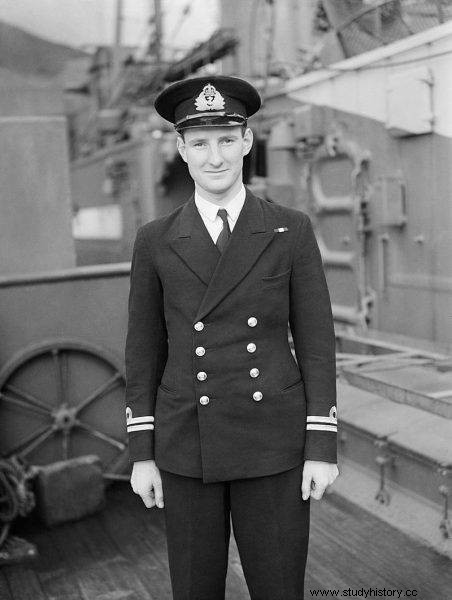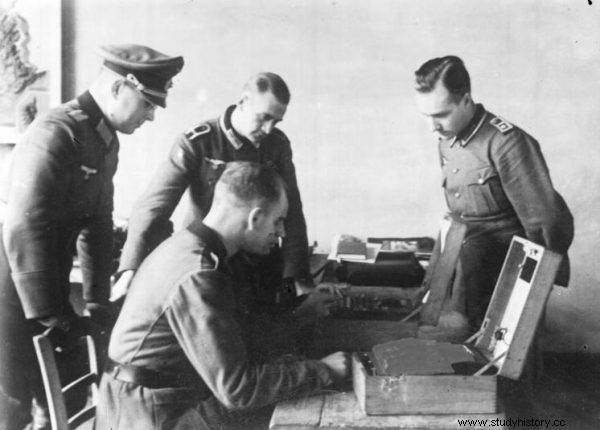Venturer made history as the only one among British and German submarines to sink two opponents. It is true that more individuals had a chance of achieving such a result, but in the end only he did!
HMS Venturer was a V-class submarine. A total of 22 units of this type were built. He was commissioned on August 19, 1943. The ship reached a surface speed of 13 knots and 9 underwater. It was armed with one 3-inch gun, three anti-aircraft guns and four bow torpedo tubes. It carried a total of 8 torpedoes on board. It did not have a stern tube.
Lieutenant Jimmy Launders was the commander of the ship. One of the crew, Watson, wrote about him:“We trusted him. We knew he was an outstanding commander. We would even follow him to the end of the world because he was so good! ”.
The unit was commissioned to Scandinavia to attack the enemy fleet in the area between Germany and southern Norway. Venturer sank a total of 13 German ships during its service, but two of them are particularly important.
How did the submarine destroy ... the plane?
The U-771 was a VIIC U-boat. It entered service in November 1943, and its commander was Lieutenant Helmut Block. The ship was stationed in Bergen, Norway. After arriving at the site, the crew was hailed of information about the numerous losses of U-boats in this area. At the end of June, U-1225 and U-478 north of the Shetland Islands and U-317 and U-319 were sunk in the waters of south-west Norway. In early July, in just three days, more units were lost:U-361, U-347 and U-742. They all fell victim to enemy aviation.
Also the U-771 had to face the "Tommies" (as the Germans called their opponents). On August 2, the U-Boat was spotted by a Mosquito of 333 Squadron. The plane was flying just above the surface of the water when, at 1.30 p.m., it tracked the emerging U-Boat escort escorting it. The Mosquito immediately launched its attack. He opened fire at a distance of 900 meters. The pilot noticed a few hits near the turret of the U-boat.
The ships did not remain in debt and immediately launched a counterattack. The plane approached the U-boat from the stern and dropped two depth charges on it from a height of only 15 meters. They exploded in five seconds. The deck of the U-boat was flooded with water and it stopped firing.

Jimmy Launders, Commander of Venturera.
The young, inexperienced pilot focused his attention on the U-Boat and did not notice that it was flying much too low. It caught the escort's mast, then plunged violently into the water. Thus, the participation in the destruction of the plane was credited to the account of the U-771. It could therefore be said that she was a lucky ship. Until…
On September 15, U-771 was transferred to Arctic patrols. From then on, he was to hunt vessels on the Great Britain-Russia route. On November 11, 1944, it reached its operational area 55 miles southwest of the Lofoten in the Norwegian Sea. HMS Venturer appeared at the same time.
The British struggled with navigation problems as the winter sun was very low, just above the horizon. So they could only rely on the position of the stars. On November 11, they were in their operating area. The watch, which was on duty in the early morning, was already over a cup of hot drink and breakfast, when suddenly at 7:35 the officer of the watch saw the enemy from a distance of 2 miles.
Duel of the underwater giants
In a situation where two enemy submarines meet, the rule was that whoever notices first, wins. This time the British were on top. Without wasting any unnecessary time, the commander ordered a course correction and fired a full fan of four torpedoes at a depth of 5.5 meters. The distance to the target was 1,820 meters.
We didn't have to wait too long for the effects of the attack. Only 19 seconds after the last torpedo was launched, a massive explosion followed, followed by numerous grinding fires. Two minutes later something exploded again - probably U-boat batteries. Despite intense observation, the target could not be found. He disappeared into the depths of the sea, and all hearing of him was lost. From the moment of noticing the enemy to his sinking, only ... 6 minutes passed! The U-771 went down with the entire 51-man crew. He made two combat patrols in total. He hasn't had any successes.
Soon after this action, Venturer's watch reported another contact. But it was only the British submarine Storm, who had come to release them from patrol in the far north. Again, Venturer was the first to spot a potential target. He made a mock attack on a colleague and then made his presence known.
Caesar targeted
The U-864 was an IXD2 submarine cruiser. It was commanded by Captain Ralf-Reimer Wolfram. On February 5, she left Bergen. The ship took part in an operation code-named "Caesar", the purpose of which was to supply Japan with valuable war material.
Hence, on board there were:construction plans of the Messerschmitt Me-163 Komet rocket-propelled interceptor, plans for the Me-262 twin-engine jet-propelled aircraft along with special documents and a contract, thanks to which the Japanese received a license to manufacture machines such as the Ju-1, Ju-6 and Campini, Caproni and Satsuki submarines, as well as radar devices. The U-Boat also transported a valuable cargo of 1,857 mercury containers. The crew was supplemented by passengers in the form of Japanese and German aviation engineers.
The first attempt at the cruise was unsuccessful. The ship was attacked by the Allied air force, and although it managed to survive the skirmish, it suffered serious damage. Its engine began to emit a loud, rhythmic clatter that could be heard by Allied ships hunting U-boats. Whether he wanted to or not, he had to return to Bergen again for repair.

The Germans still did not realize that the Enigma code had been cracked.
The Germans did not realize then that the Enigma code had been cracked. Meanwhile, the Allies were deciphering the broadcast messages and knew about Operation Caesar. The Allied Command was aware that such a valuable cargo could contribute to extending the war in the Pacific. So he ordered the Venturer in the area to intercept and destroy the unit. Launders received a report that the enemy was near Fedje Island, but finding him was still quite a challenge.
A masterpiece of command
Launders, however, was an outstanding commander. He made a risky, but - as it later turned out - right decision. He ordered to switch off his Azjuk, a device that allowed him to target the submarine. Why? Launders realized that this would reduce the likelihood of finding the enemy, but also reduce the risk of being spotted himself. He chose to rely only on the sonar. The highest stakes were at stake.
U-864 was already outside the area previously designated by the Royal Navy command. He would probably have successfully escaped the British if the U-Boat commander had not decided to return to Bergen to repair the noisy engine. This brought the ship closer to the area of Fedje Island, patrolled by Venturer.
The sonar staff reported strange noises that they were unable to identify. It was supposed that it was just a fishing boat that had just fired the diesel engines. Launders, however, decided to investigate the trail. Soon after that, periscope observation noticed the tip of the periscope sticking out of the water. The commander understood that the strange noise was coming from a submerged submarine. There was no other option - it had to be U-864!
The British only tracked their target using the sonar. Launders hoped that at some point the U-Boat would emerge and allow him to make a precise attack. However, the Germans also knew about the presence of a submarine in the area. Not only were they submerged, but they also began to zigzag. This procedure was to ensure their sufficient safety.
The U-Boat periscope was spotted at 11:15. Launders wrote in his logbook:"The target makes very loud mechanical noises, kind of like air compressors - definitely not humming." . Two minutes later, the target changed course and sailed over to the British starboard. Venturer had to wait for a better opportunity before attacking.
After five minutes, the periscope was again noticed protruding from the water. The target was aft of the English. It was then that Launder realized that the enemy was countercourse towards Bergen. So an immediate correction was made. At 11.51 a.m. it was established that the distance to the enemy unit was approximately 1,800 meters. The Venturer was traveling at 3.5 knots.

Location of the wreckage U-864
By 12.12 the target was on the starboard side and was still zigzagging. It was at this point that Launder - using passive gas and previous calculations - decided to attack. At 8-second intervals, he fired a full salvo of four torpedoes aimed at a depth of 12 meters. He fired from the submersion!
Two minutes later there was an explosion, followed by a sound of bulkhead breaking. A dozen or so seconds later there were two more, probably due to a torpedo explosion in contact with the land behind the attacked ship. Launders concluded that the first or the last torpedo fired must have reached the target. There was silence in the Hydrophone.
At 12.40 p.m. by periscope observation, gulls were gathering on the starboard side just aft. Launders decided to explore the area. As he approached the designated area, he noticed that the color of the water was changing dramatically. There was also an object drifting on the surface of the sea. A deck torpedo or a spare tank was recognized in it. All this together proved to the British that they had sunk U-864. The submarine cruiser went to the bottom with all its crew and precious cargo just 35 miles from Bergen.
Double record holder
Upon his return to base, Launders was awarded the Distinguished Service Order (DSO). He was the only commander of a submarine in the Royal Navy who managed to destroy two U-boats . He was also the only one (to this day) who managed to sink another submerged ship from under the water. He achieved both successes in just three months!
What about his ship? Venturer lived to see the end of the war and was sold to the Norwegian Navy in 1946. Its name was renamed Utstein.
